

Tran Quoc Pagoda is not only a spiritual tourist destination, but also a cultural symbol of Hanoi, containing many historical and architectural values. Join BDATrip to discover the interesting things about Pagoda in this article!
Tran Quoc Pagoda is located on a small peninsula in West Lake, with an ancient and sacred appearance. The pagoda was built in 545, as a place to worship Buddha Shakyamuni and Bodhisattva Avalokitesvara - two saints of Buddhism. The pagoda also preserves 14 Buddha statues made of precious wood brought from India in the 6th century.
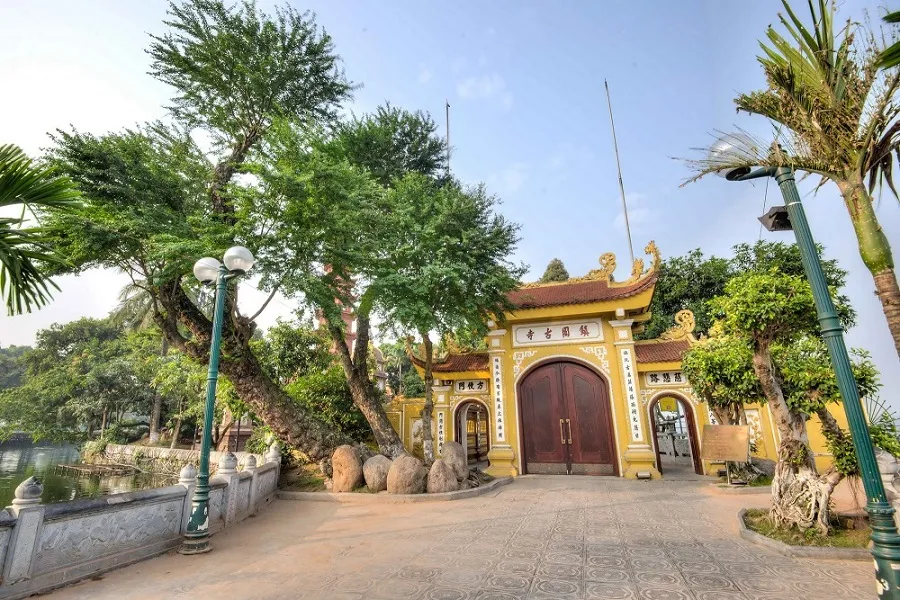
Tran Quoc Pagoda has a history of nearly 1500 years and is considered the oldest pagoda in Thang Long - Hanoi. According to historical documents, the pagoda was built in 541 under the reign of King Ly Nam De with the name Khai Quoc (meaning to enlighten the nation). Initially, the pagoda was built on the bank of the Red River, near Y Hoa village (now in Long Bien district). Later, in 1615, King Le Than Tong allowed the pagoda to be moved inside Yen Phu dyke, on the old foundation of Thuy Hoa palace (Ly dynasty) and Han Nguyen palace (Tran dynasty). Since then, the pagoda was renamed Tran Quoc (meaning to protect the nation).
In 1624, 1628 and 1639, the pagoda was renovated and expanded several times. At the beginning of the Nguyen dynasty, the pagoda was renovated again, cast bells, and sculpted statues. In 1821, King Minh Mang visited the pagoda and granted 20 taels of silver to repair it. In 1842, King Thieu Tri also visited the pagoda and granted more gold and silver to maintain it.
During the resistance wars against France and America, the pagoda was a hiding place and a place of activity for many revolutionaries and doctors. The pagoda also went through many times of being destroyed and burned by the enemy. After 1975, the pagoda was restored and preserved as a national historical - cultural relic.
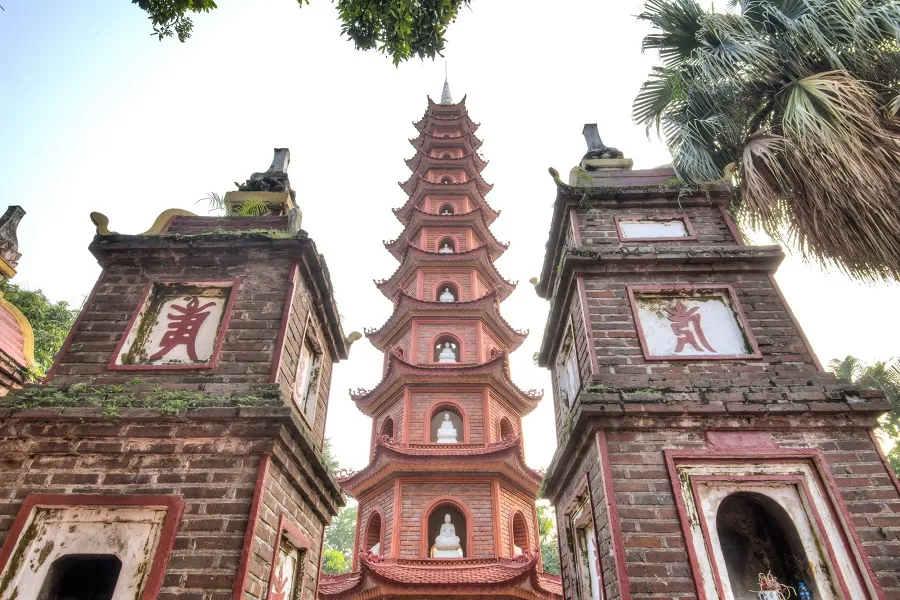
The temple is not only an ancient Buddhist temple, but also a symbol of the national spirit and culture of Hanoi. The temple is a testament to the connection between the national spirit and Buddhist culture in the history of struggle of the Vietnamese people. Nowadays, the temple has become one of the most popular tourist destinations in Hanoi.
Tran Quoc Pagoda is located at No. 5 Thanh Nien Street, Yen Phu Ward, Tay Ho District, Hanoi. This is a convenient location, easy to move from other areas of the city. Tourists can go to the pagoda by various means of transportation such as:
- Bus: You can take bus number 31, 33, 55 or 58 and get off at Thanh Nien - Yen Phu station. From there, you just need to walk about 300 meters to reach the pagoda.
- Motorbike and car: You can go along Vo Chi Cong Street, turn into Thanh Nien Street and go straight to the pagoda. You can park your motorbike at the pagoda’s parking lot for 10,000 VND / vehicle.
Opening hours of Tran Quoc Pagoda from 5 am to 9 pm. Visitors can enter the pagoda at any time within this time frame to visit and worship. However, this is always a famous cultural and spiritual tourist destination, attracting many people. If you want to avoid crowds and enjoy the fresh and peaceful atmosphere of the pagoda, you should come early in the morning or in the afternoon.
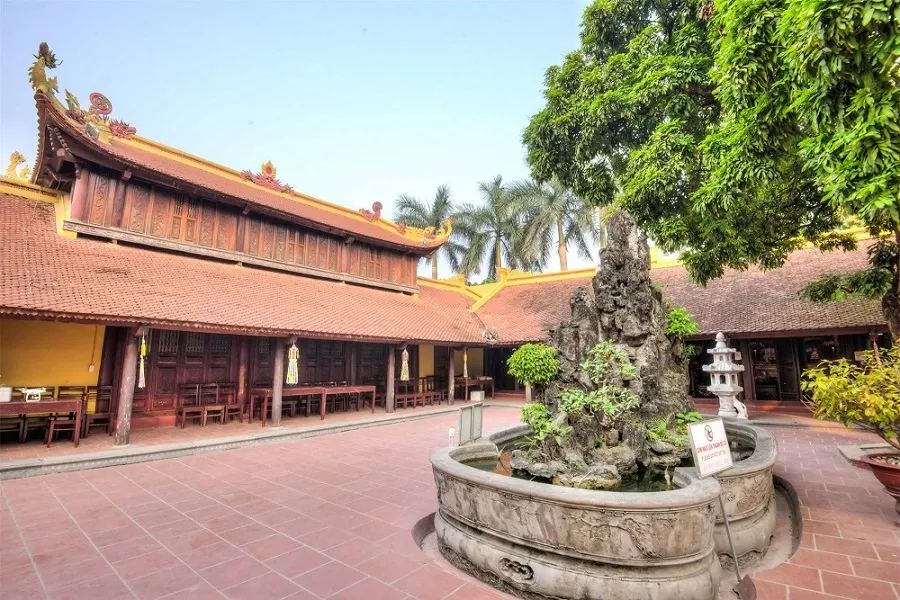
The entrance fee to pagoda is free for all visitors. You just need to follow the rules of the pagoda when entering, such as dressing modestly, not bringing pets, not making noise or insulting religion…
Tran Quoc Pagoda is a traditional and majestic Buddhist temple in Hanoi. The pagoda has many beautiful and meaningful architectural works, built from wood, stone and glazed tiles. The pagoda covers an area of about 3000 square meters, located on a small peninsula in West Lake.
Some of the prominent works of the pagoda are:
- Tam Quan: The main gate of the pagoda, with three large doors and two small doors. Tam Quan has the name of the pagoda and the year of construction written in Chinese characters along with many decorative patterns.
- Dai Hung Bao: The main hall of the pagoda, where Buddha Shakyamuni and Bodhisattva Avalokitesvara are worshiped. Dai Hung Bao has a red tile roof, green wooden columns and white walls, very harmonious in color. Inside Dai Hung Bao there are 14 Buddha statues made of precious wood from India and a 15-meter-high Amitabha Buddha statue made of gold.
- Bao Thap Tower: A 15-meter-high tower, with 11 floors and 6 sides. Each side has a hexagonal window, in which a small bell is hung. On top of the tower there is a Buddhist wheel symbolizing reincarnation.
- Phat Quang Dai: This work is located behind Dai Hung Bao, with modern architecture, with a blue tile roof and white wooden columns. Inside Phat Quang Dai there is a 4-meter-high Maitreya Buddha statue made of jadeite stone.
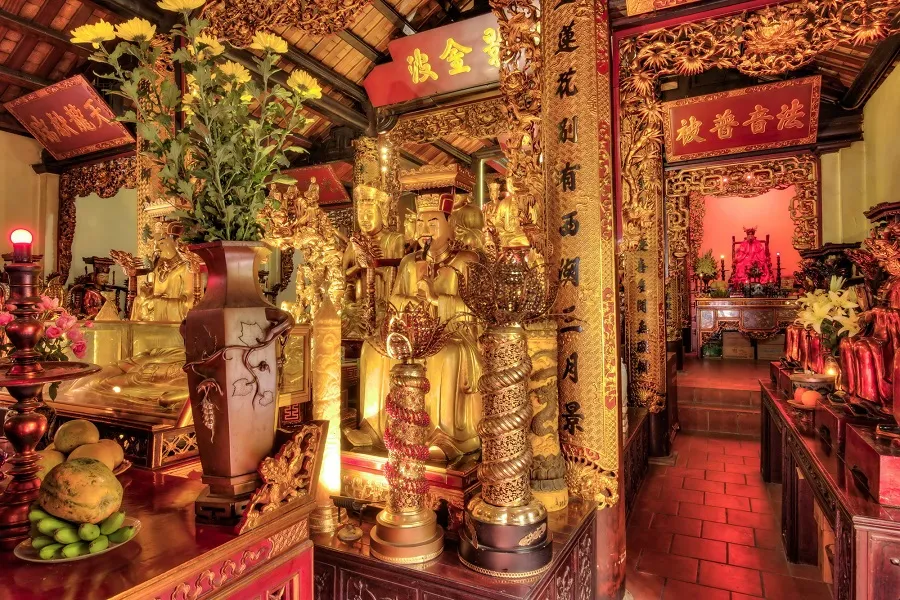
Many tourists come to Tran Quoc Pagoda to admire the beautiful architecture, feel the serene atmosphere and worship Buddha for peace for themselves and their relatives. You can buy offerings such as incense, flowers, fruits, candy … at the stalls outside the pagoda or bring them from home to offer on the altars. You can also ask for guidance or prayers from the nuns and monks at the pagoda. If you are lucky, you may be given some souvenirs such as bracelets, beads, scriptures, Buddha pictures …
The bodhi tree is a type of woody plant that has a special meaning in Buddhism. According to legend, Buddha Shakyamuni attained enlightenment under a bodhi tree in India. The bodhi tree symbolizes the wisdom and awakening of the Buddha and the Bodhisattvas.
Here, there is an ancient bodhi tree, planted from a branch of the bodhi tree in India - where Buddha Shakyamuni attained enlightenment. This bodhi tree was recognized by UNESCO as a World Cultural Heritage in 1962. The bodhi tree of Tran Quoc Pagoda is over 100 years old and has a height of about 25 meters. The tree has a large trunk and roots that grow outwards, creating an impressive and majestic image. The tree also has green leaves and fragrant white flowers, bringing a sense of purity and peace to the viewer.
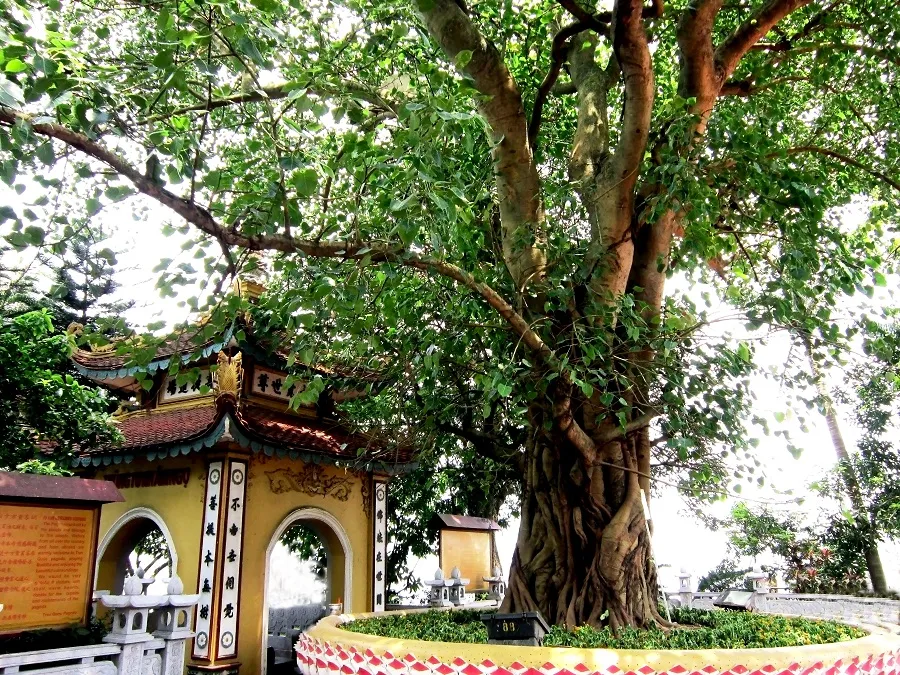
Many visitors come to the pagoda to admire this bodhi tree and pray for the blessings of the Buddha. You can also touch the trunk or fallen leaves to feel the vitality and sacredness of the tree.
Tran Quoc Pagoda is a place to preserve many Buddhist art treasures, with statues of Buddha and Bodhisattva made from many precious materials, such as wood, stone, pottery, gold … These statues not only show the talent of the sculptors, but also have profound spiritual meanings, symbolizing the noble qualities of the Buddha and Bodhisattva, such as compassion, wisdom, liberation …
Among the statues of the pagoda, there are three particularly outstanding ones:
- Statue of Buddha Shakyamuni: This statue is in Dai Hung Bao, nearly 3 meters high and carved from precious wood.
- Statue of Bodhisattva Avalokitesvara: The statue is over 2 meters high with the posture of Bodhisattva Avalokitesvara sitting cross-legged, with a graceful face and a hand holding a lotus vase, showing compassion and salvation.
- Statue of Amitabha Buddha: This is the tallest statue in the pagoda, 15 meters high and covered with 2000 gold leaves. The statue of Amitabha Buddha is worshiped in Phat Quang Dai, with a sitting cross-legged posture, a smiling face and a hand holding a bead chain, showing happiness and peace.
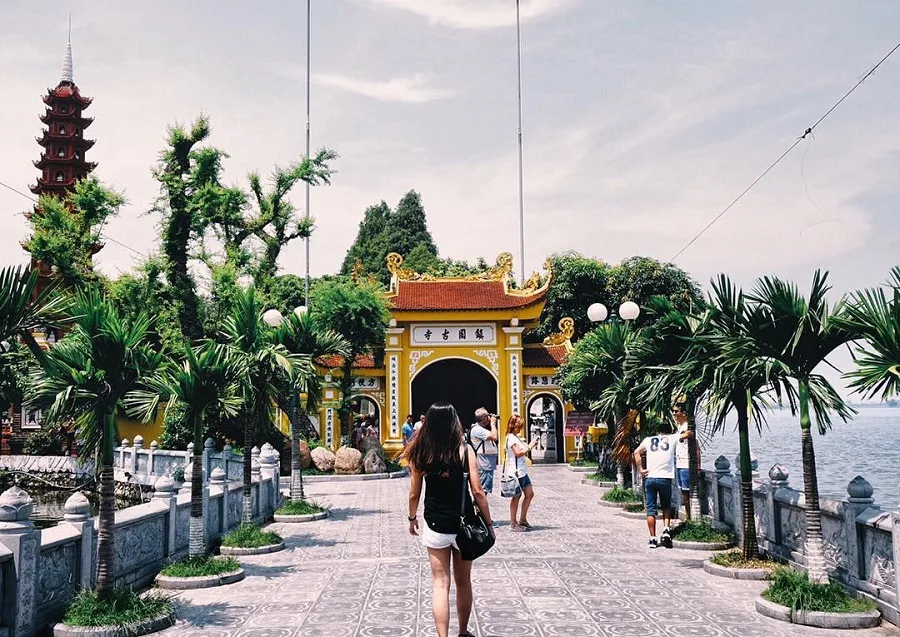
Tran Quoc Pagoda is an attractive destination with unique spiritual and cultural activities, deeply embedded in the national identity. Some of the prominent activities usually organized at Tran Quoc Pagoda include:
- Ceremonies of Praying for Safety and Deliverance of the Soul: Held annually, these ceremonies attract a large number of Buddhists and tourists, aiming to pray for peace, luck, and health. The Deliverance of the Soul ceremony is also dedicated to remembering and praying for the deceased.
- Vu Lan Festival - Filial Piety: One of the most significant and important festivals of the year at the pagoda, the Vu Lan Festival takes place in the seventh lunar month annually, expressing gratitude and filial piety of children towards their parents.
- Meditation and Buddhist Teachings: The pagoda also regularly organizes meditation sessions and teachings about Buddhism, attracting not only locals but also international tourists interested in Buddhist culture and philosophy.
- Spring Festival of the Lunar New Year: This event welcomes the New Year with various traditional activities like ceremonies for peace and fortune, and other cultural events.
- Upper Yuan Festival (Full Moon of the First Lunar Month): Held on the full moon day of the first lunar month, this festival emphasizes praying for a new year filled with luck and happiness.
- Exhibitions and Seminars: The pagoda frequently organizes exhibitions on Buddhist art, as well as seminars on the history, culture, and philosophy of Buddhism, attracting the interest of both the academic community and tourists.
- Buddha's Birthday Celebration: Commemorating the birth of Buddha, the Buddha's Birthday is usually celebrated in the fourth lunar month with many unique spiritual and cultural activities.
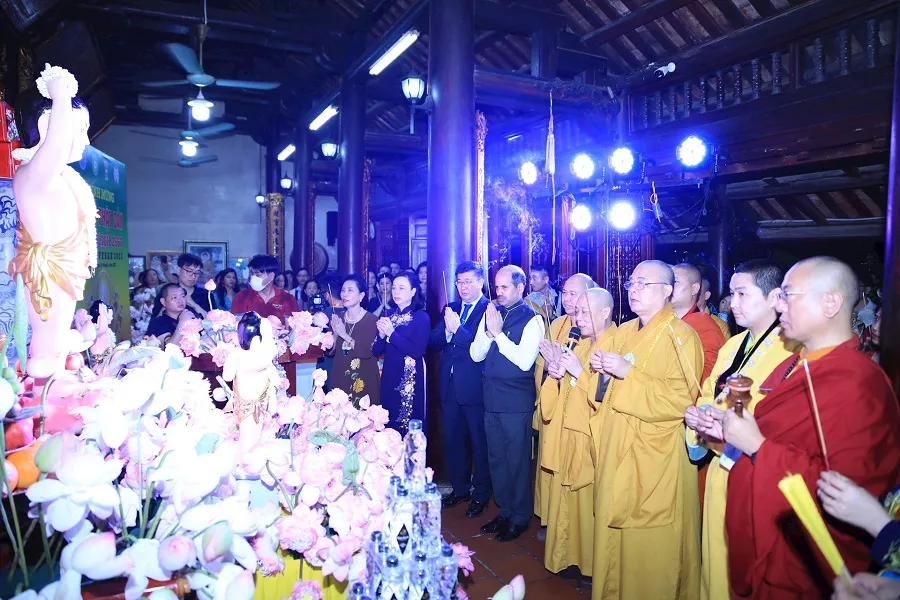
The activities at Dien Huu Temple not only represent deep spiritual values but also demonstrate the diversity and richness of Vietnamese Buddhist culture. They provide an extensive insight into the traditions and spiritual beliefs, reflecting the soul and thoughts of the Vietnamese people.
Tran Quoc Pagoda is a precious historical and cultural relic of Vietnamese Buddhism. When visiting the pagoda, you need to pay attention to the following things to have a complete cultural and spiritual trip:
- Dress politely: You should wear modest clothes, not too short or revealing, to respect the religion and culture of the pagoda.
- Do not bring pets: You should not bring your pets when visiting the pagoda, as it is a disrespectful act and can cause trouble for others.
- Do not make noise or offend religion: Keep quiet or speak softly when in the pagoda, so as not to disturb those who are praying or meditating. You should also respect the religious symbols, do not touch or take pictures of the Buddha and Bodhisattva statues in a careless way.
- Do not use tobacco, alcohol or food with a bad smell: Do not smoke, drink alcohol or eat foods with a bad smell such as garlic, onion … when visiting the pagoda as they are bad behaviors and pollute the atmosphere in the pagoda.
We hope this article has provided you with useful information about Tran Quoc Pagoda - the oldest and most sacred pagoda in Hanoi.
Copyright © 2022 BDATrip.com | All rights reserved.